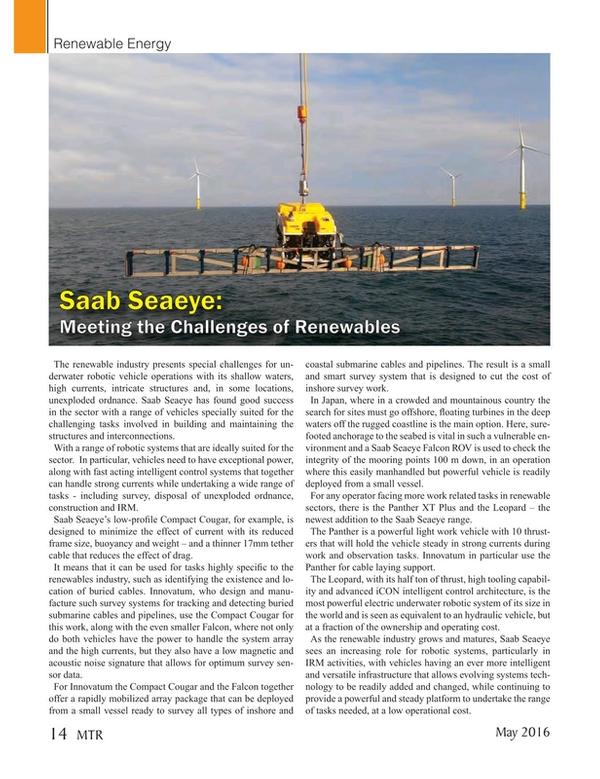
Saab Seaeye: Meeting the Challenges of Renewables
Marine Technology Reporter
The renewable industry presents special challenges for underwater robotic vehicle operations with its shallow waters, high currents, intricate structures and, in some locations, unexploded ordnance. Saab Seaeye has found good success in the sector with a range of vehicles specially suited for the challenging tasks involved in building and maintaining the structures and interconnections.
With a range of robotic systems that are ideally suited for the sector. In particular, vehicles need to have exceptional power, along with fast acting intelligent control systems that together can handle strong currents while undertaking a wide range of tasks - including survey, disposal of unexploded ordnance, construction and IRM.
Saab Seaeye’s low-profile Compact Cougar, for example, is designed to minimize the effect of current with its reduced frame size, buoyancy and weight – and a thinner 17mm tether cable that reduces the effect of drag.
It means that it can be used for tasks highly specific to the renewables industry, such as identifying the existence and location of buried cables. Innovatum, who design and manufacture such survey systems for tracking and detecting buried submarine cables and pipelines, use the Compact Cougar for this work, along with the even smaller Falcon, where not only do both vehicles have the power to handle the system array and the high currents, but they also have a low magnetic and acoustic noise signature that allows for optimum survey sensor data.
For Innovatum the Compact Cougar and the Falcon together offer a rapidly mobilized array package that can be deployed from a small vessel ready to survey all types of inshore and coastal submarine cables and pipelines. The result is a small and smart survey system that is designed to cut the cost of inshore survey work.
In Japan, where in a crowded and mountainous country the search for sites must go offshore, floating turbines in the deep waters off the rugged coastline is the main option. Here, sure-footed anchorage to the seabed is vital in such a vulnerable environment and a Saab Seaeye Falcon ROV is used to check the integrity of the mooring points 100 m down, in an operation where this easily manhandled but powerful vehicle is readily deployed from a small vessel.
For any operator facing more work related tasks in renewable sectors, there is the Panther XT Plus and the Leopard – the newest addition to the Saab Seaeye range.
The Panther is a powerful light work vehicle with 10 thrusters that will hold the vehicle steady in strong currents during work and observation tasks. Innovatum in particular use the Panther for cable laying support.
The Leopard, with its half ton of thrust, high tooling capability and advanced iCON intelligent control architecture, is the most powerful electric underwater robotic system of its size in the world and is seen as equivalent to an hydraulic vehicle, but at a fraction of the ownership and operating cost.
As the renewable industry grows and matures, Saab Seaeye sees an increasing role for robotic systems, particularly in IRM activities, with vehicles having an ever more intelligent and versatile infrastructure that allows evolving systems technology to be readily added and changed, while continuing to provide a powerful and steady platform to undertake the range of tasks needed, at a low operational cost.
(As published in the May 2016 edition of Marine Technology Reporter)
Read Saab Seaeye: Meeting the Challenges of Renewables in Pdf, Flash or Html5 edition of May 2016 Marine Technology


